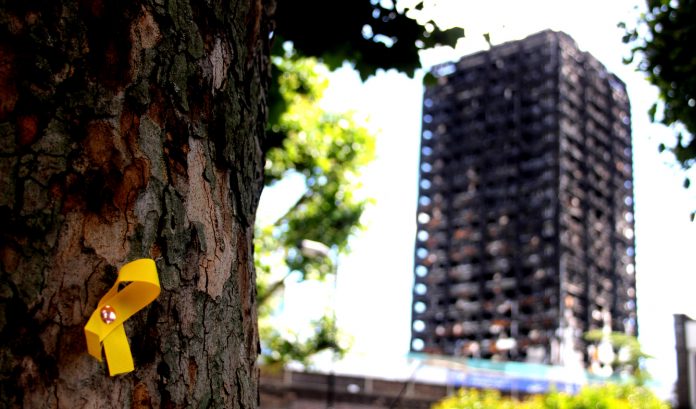Dr Dave Smith, export manager of the Fire Industry Association, looks at the changing landscape for competency in the wake of the Grenfell disaster and Dame Judith Hackitt’s review of fire safety and the Building Regulations
The Grenfell Tower tragedy, which claimed 72 lives on 14 June 2017, is a devastating manifestation of the failure of fire safety legislation, regulation and indeed funding over a number of years in the UK. The stark reality is that policies stretching back over decades and affecting housing, local government and the fire and rescue services has led to cuts in public services, deregulation and privatisation, which in turn has precipitated a deep-seated complacency and a culture in which fire policy and fire safety has fallen well below the necessary standards.
This conclusion is hard to refute when the Grenfell disaster was preceded by the Harrow Court incident in 2005, the Lackanal House fire in 2009 and the Shirley Towers blaze in 2010, with the Hackitt Review noting pointedly that lessons had not been learned from previous incidents.
Building a Safer Future
The report by Dame Judith Hackitt entitled Building a Safer Future: Independent Review of Building Regulations & Fire Safety offered a coruscating critique of the current fire safety regime. It states that roles and responsibilities for building safety are unclear, regulations and guidance are “ambiguous and inconsistent”, compliance processes are “weak and complex”, product testing and marketing are “opaque and insufficient” and that the competence of people engaged in the system is “patchy”.
Dame Judith noted that wholesale cultural change is “absolutely fundamental” and requires change from a “prime motivation to do things as quickly and cheaply as possible” with the need for people to “take responsibility for the decisions they are making” and “to take responsibility for complying with the requirements”.
With so much that could be said about the failings that led to Grenfell and the wide-ranging set of recommendations and outcomes that continue to emerge, our focus here is largely on one of the key recommendations, that of competency. While there are many demonstrable cases of good practice, the means by which practitioners throughout the system reach acceptable levels of competency and are accordingly assessed and certificated are inadequate.
As a result, there is an urgent need to ensure that those undertaking work throughout the lifecycle of any building have the necessary levels of skills, knowledge and expertise and that government makes sufficient investment in enabling the attainment and monitoring of competency. This would require a significant reversal in government’s deregulatory policy and massive funding, bearing in mind that this investment would be spread across the fire safety and construction industries. It appears most likely that responsibility will be largely delegated to relevant professional institutions and industry bodies, and these organisations have already been instrumental in taking forward many of the proposals arising from Hackitt.
Enabling competency
The Fire Industry Association (FIA) welcomed the Hackitt Report, having called over many years for improvements to the regulatory environment and competency levels in the UK fire safety industry. The FIA’s colours have long been firmly nailed to its mast with a range of industry-best training courses for individuals and a membership criterion that demands company certification to a relevant third-party scheme (or ISO 9001 where no such scheme exists). In these ways, it takes responsibility for both enabling competency in the sector and providing assurance that FIA members deliver credibility and the very highest quality in the provision of products and services.
Its commitment to industry training took a quantum leap at the start of 2018 when the FIA became an Awarding Organisation and converted its suite of training courses in order to offer specialised qualifications recognised by OFQUAL in England, QIW in Wales and CCEA in Northern Ireland. Taking candidates to Level 3 on the Regulated Qualifications Framework (and Level 4 on the European Qualifications Framework), it provides assurance that practitioners thus qualified carry out their work in compliance with current legislation, industry best practice and published standards and guidances. Further to this, as part of a process of continuous improvement and based on consultation with its members, the FIA has just introduced a new and more concise Level 3 qualification entitled Fundamentals of FD&A in Non-Domestic Premises.
The FIA has also been active on the Competency Steering Group (CSG), fielding experts on three of its 12 Working Groups covering Installers, Fire Engineering and Fire Risk Assessment. All these groups examined what competency means in practice in their areas of concern and this resulted in the issue of an interim report Raising the Bar, which sets out a package of measures to address the shortfalls identified by Hackitt.
Its recommendations include the inauguration of a new oversight body, a building safety register, a shorter competency reassessment period and basic fire science as part of Continuing Professional Development (CPD).
Chairman of the CSG, Graham Watts, said “the working groups are proposing to raise the bar through a more rigorous approach including training, assessment, reassessment and third-party accreditation” which will result in “a paradigm change to improve competence and industry culture”. Its emphasis on competence features a call for government to mandate those working on high-rise buildings to be registered/certificated by a recognised professional or certified body, for those assessing competence to be subject themselves to oversight by a body such as UKAS, and for the building safety regulator to hold and maintain a register of those qualified to carry out key roles associated with building safety.
Taking as an example the design, installation, commissioning and maintenance of fire detection and alarm (FD&A) systems, the case for demonstrable competency is clear.
The Gas Safe scheme that replaced the Corgi Registered scheme in 2009 made it illegal for anyone not registered to carry out the work of a gas engineer, entirely sensible given the high-risk nature of incorrectly installed or maintained boilers. FD&A systems are also life-critical as failure to activate in the event of fire cost lives but incredibly, there is no such equivalent to Gas Safe. With around 50 people dying every year in the UK of carbon monoxide poisoning and 350-400 dying annually from fire, it is surely time for a Fire Safe register in which fully qualified personnel and companies can be identified.
Post-Grenfell public inquiry
In other developments post-Grenfell, the public inquiry headed by Sir Martin Moore-Bick has published its Phase 1 report, which covers the timeline of Grenfell events, the response of London Fire Brigade and a series of recommendations arising from the facts as they are now known. Phase 2 is likely to be more relevant to the fire protection industry as it will bring further analysis of the design, construction and management of the building.
Amendments to Building Regulations
There is also the Building [Amendment] Regulations that came into force in December 2018, along with an associated amendment to Approved Document B. it introduces major restrictions on the combustibility of materials used within external walls of certain types of “relevant buildings” in England. At the same time, government initiated a technical review of Approved Document B, the responses to the call for evidence being published in September last year.
Building Safety Bill
Bringing us up to date, the State Opening of Parliament in January saw the government set out its Building Safety Bill, which creates a commitment to fundamental changes to the regulatory framework for high-rise residential buildings and claims to take forward “all 53 of the Hackitt recommendations…and in some areas going further”.
Progress, however, is slow. In June last year, of 328 buildings that needed their aluminium composite material cladding replaced, 221 were yet to begin remedial work and while £200m has been pledged to remove this cladding from privately owned blocks, calls remain to extend funding to other forms of cladding and other fire safety measures.
Furthermore, the new building safety legislation to which we referred will go through publication and passage through parliament, which will see it enter the statute books around four years after the Grenfell tragedy.
Fire and rescue services
Meanwhile, the fire and rescue services are reeling from huge cuts in funding, spend falling from £3.118bn in 2009-10 to £2.739bn in 2018-19, a drop of £379m annually and resulting in a 22.6% fall in firefighters over that period. The LFB, so heavily criticised in the Moore-Bick report, lost 10 fire stations, 27 fire appliances and over 500 personnel under the mayoral control of Boris Johnson.
If the government is true to its word, we will theoretically be in a much stronger position in a few years’ time than we are now in respect of fire safety in this country but why is there scepticism that this improved position can be genuinely reached? The answer lies primarily in whether government will lead on the implementation of the recommendations (and not just for high-rise buildings) and provide the necessary funding to bring these proposals to fruition.
There has been an increasing tendency for government to devolve responsibility to industry, which on the face of it is reasonable as it places the onus on experts rather than ministers and civil servants. Where it fails, however, is in leaving industry bodies to fund the infrastructure and resource requirements needed to implement and maintain a vast swathe of actions, just some of which have been covered here. A related issue concerns certain initiatives being mandatory rather than advisory and this would apply, for example, to a register of competent personnel and third-party certification. Industry can and, in many cases, has created these schemes but has no jurisdiction to demand compliance; only government has the legislative power to do that.
Export manager
Fire Industry Association
Tel: +44 (0)20 3166 5002
Twitter: @fireindustry
Youtube: The Fire Industry












![[Video] Enhancing safety with fire doors: A case study of Marina Care Home](https://www.pbctoday.co.uk/news/wp-content/uploads/2025/06/maxresdefault-218x150.jpg)


